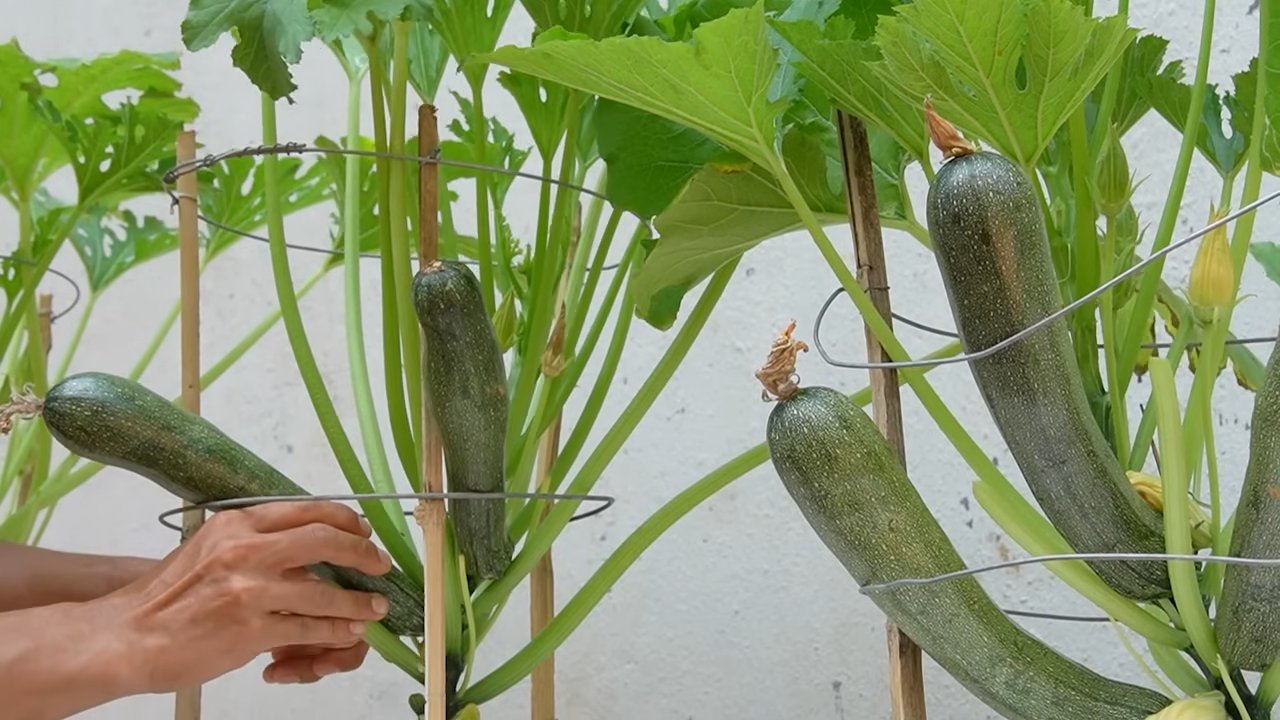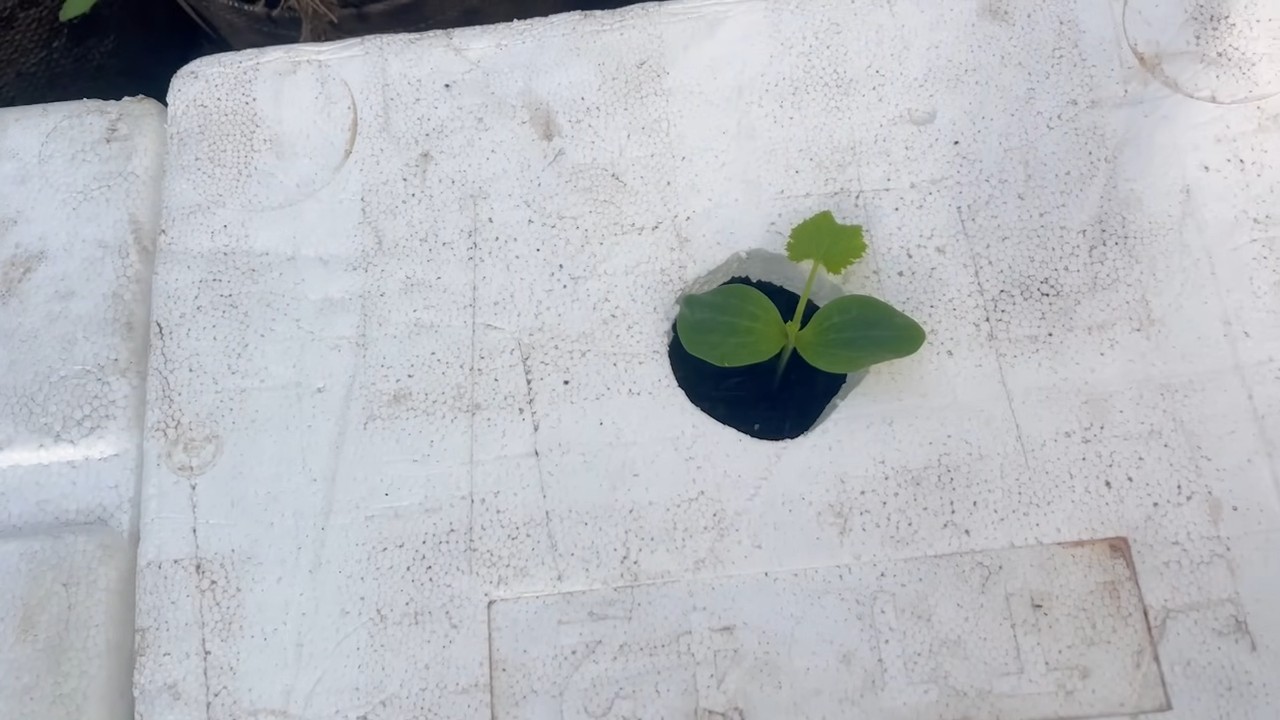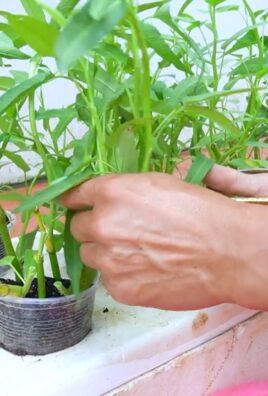Zucchini growing tips are your secret weapon to unlocking a summer bounty right in your own backyard! Have you ever dreamed of harvesting so many zucchinis that you’re practically giving them away to neighbors? Or maybe you’re tired of those tiny, lackluster zucchinis from the grocery store? Well, get ready to transform your garden and your plate with these simple, yet effective, DIY tricks.
For centuries, the zucchini, a member of the squash family, has been a staple in cuisines worldwide. Originating in the Americas, it made its way to Europe and beyond, becoming a beloved vegetable for its versatility and ease of cultivation. But even with its relatively simple nature, maximizing your zucchini yield requires a little know-how. That’s where these DIY hacks come in!
Let’s face it, gardening can sometimes feel overwhelming. Pests, diseases, and unpredictable weather can all throw a wrench in your plans. But don’t worry, I’m here to share some tried-and-true methods that will help you overcome common zucchini growing challenges. These aren’t just random tips; they’re practical, actionable steps you can take today to ensure a thriving zucchini patch. From soil preparation to pollination techniques, we’ll cover everything you need to know to become a zucchini-growing pro. So, grab your gardening gloves, and let’s dive into these amazing zucchini growing tips that will have you harvesting a bumper crop in no time!

Unlocking Zucchini Abundance: A DIY Guide to Bumper Crops!
Hey fellow gardeners! Are you dreaming of zucchini bread, zucchini fritters, and zucchini noodles galore? I know I am! But sometimes, getting those prolific harvests can feel like a challenge. Don’t worry, I’m here to share my tried-and-true DIY hacks for maximizing your zucchini yield. Let’s get those plants thriving!
Understanding Zucchini Needs
Before we dive into the DIY magic, let’s quickly cover the basics. Zucchini are hungry, thirsty plants that love sunshine. Knowing their needs is half the battle!
* Sunlight: Zucchini needs at least 6-8 hours of direct sunlight per day.
* Soil: Well-draining soil rich in organic matter is crucial.
* Water: Consistent watering is key, especially during fruiting. Aim for deep watering a few times a week rather than shallow watering daily.
* Fertilizer: Zucchini are heavy feeders. Regular fertilization will keep them happy and productive.
* Pollination: Zucchini relies on pollination to produce fruit. We’ll talk about how to help with that!
DIY Hack #1: Supercharging Your Soil with Compost Tea
Compost tea is like a superfood smoothie for your zucchini plants. It’s packed with beneficial microbes and nutrients that will boost their growth and immunity.
What you’ll need:
* A 5-gallon bucket
* An aquarium air pump and air stone
* A porous bag (like a paint strainer bag or old pillowcase)
* High-quality compost (worm castings are amazing!)
* Unchlorinated water (let tap water sit out for 24 hours to dechlorinate)
* Molasses (optional, but it feeds the microbes)
Step-by-step instructions:
1. Fill the bucket: Fill the 5-gallon bucket with unchlorinated water, leaving a few inches at the top.
2. Add the compost: Place about 1-2 cups of compost into the porous bag and tie it securely.
3. Submerge the bag: Submerge the bag of compost into the water.
4. Aerate the mixture: Place the air stone at the bottom of the bucket and connect it to the air pump. Turn on the air pump. This is crucial for creating an oxygen-rich environment where beneficial microbes can thrive.
5. Add molasses (optional): If you’re using molasses, add about 1 tablespoon to the water.
6. Brew the tea: Let the tea brew for 24-48 hours, stirring occasionally. The water should become a dark, tea-like color.
7. Strain and dilute: Remove the compost bag and strain the tea through a fine-mesh strainer or cheesecloth. Dilute the tea with water until it’s the color of weak tea (usually a 1:10 ratio).
8. Apply to plants: Water your zucchini plants with the diluted compost tea, focusing on the base of the plant. You can also use a spray bottle to apply it to the leaves (foliar feeding). I like to do this in the early morning or late evening to avoid burning the leaves.
I usually apply compost tea every 2-3 weeks during the growing season. You’ll be amazed at the difference it makes!
DIY Hack #2: Hand-Pollinating for Guaranteed Fruit Set
Sometimes, even with plenty of bees around, zucchini pollination can be spotty. This is where hand-pollinating comes in! It’s a simple way to ensure you get lots of zucchini.
Understanding Zucchini Flowers:
Zucchini plants have both male and female flowers. Male flowers have a long, thin stem, while female flowers have a small zucchini-like fruit at the base of the flower. You need pollen from the male flower to fertilize the female flower.
What you’ll need:
* A small paintbrush or cotton swab
* Or, you can simply use the male flower itself
Step-by-step instructions:
1. Identify male and female flowers: Look for open male and female flowers on your zucchini plant. The flowers are usually open in the early morning.
2. Collect pollen: Gently rub the paintbrush or cotton swab inside the male flower to collect pollen. If using the male flower itself, pluck it from the plant.
3. Transfer pollen: Gently rub the pollen-covered paintbrush or cotton swab onto the stigma (the center part) of the female flower. If using the male flower, remove the petals and gently rub the stamen (the pollen-covered part) onto the stigma of the female flower.
4. Mark the pollinated flower: I like to tie a small piece of yarn or ribbon around the stem of the pollinated female flower so I know which ones I’ve already done.
5. Observe: Over the next few days, you should see the small zucchini fruit at the base of the female flower start to grow. If it turns yellow and shrivels up, it wasn’t successfully pollinated.
I usually hand-pollinate my zucchini plants every morning for a few weeks after they start flowering. It’s a bit of extra work, but it’s totally worth it for the guaranteed zucchini!
DIY Hack #3: Epsom Salt for Magnesium Boost
Epsom salt (magnesium sulfate) is a great way to give your zucchini plants a boost of magnesium, which is essential for chlorophyll production and overall plant health. Magnesium deficiency can lead to yellowing leaves and reduced fruit production.
What you’ll need:
* Epsom salt
* Watering can
Step-by-step instructions:
1. Dissolve the Epsom salt: Dissolve 1 tablespoon of Epsom salt in 1 gallon of water.
2. Water your plants: Water your zucchini plants with the Epsom salt solution, focusing on the base of the plant.
3. Repeat: Repeat this process every 2-3 weeks during the growing season.
I’ve found that Epsom salt really helps to keep my zucchini plants healthy and green, especially in areas with alkaline soil.
DIY Hack #4: Companion Planting for Pest Control and Enhanced Growth
Companion planting is the practice of planting different plants together to benefit each other. Some plants can repel pests, attract beneficial insects, or improve soil conditions for their neighbors.
Great Companion Plants for Zucchini:
* Marigolds: Repel nematodes and other pests.
* Nasturtiums: Attract aphids away from zucchini and attract beneficial insects.
* Borage: Attracts pollinators and beneficial insects.
* Garlic and Onions: Repel pests.
* Beans and Peas: Fix nitrogen in the soil, which benefits zucchini.
How to Implement Companion Planting:
Simply plant these companion plants around your zucchini plants. I like to interplant them directly in the same garden bed. For example, I might plant marigolds around the perimeter of the bed and interplant nasturtiums and borage among the zucchini plants.
Companion planting is a natural and effective way to improve the health and productivity of your zucchini plants.
DIY Hack #5: Pruning for Increased Airflow and Sunlight
Pruning zucchini plants can seem counterintuitive, but it can actually help to increase airflow, improve sunlight penetration, and encourage fruit production.
When to Prune:
* Remove yellowing or damaged leaves.
* Remove leaves that are blocking sunlight from reaching the fruits.
* Remove overcrowded leaves to improve airflow.
How to Prune:
1. Use clean pruning shears: Make sure your pruning shears are clean and sharp to prevent the spread of disease.
2. Cut at the base of the leaf: Cut the leaf stem close to the main stem of the plant.
3. Don’t remove too many leaves at once: Remove only a few leaves at a time to avoid stressing the plant.
I usually prune my zucchini plants every week or two, removing any leaves that are yellowing, damaged, or blocking sunlight.
DIY Hack #6: Vertical Growing for Space Saving and Better Air Circulation
If you’re short on space or want to improve air circulation around your zucchini plants, consider growing them vertically. This can be done using a trellis or other support structure.
What you’ll need:
* A sturdy trellis or other support structure (like a tomato cage)
* Twine or plant ties
Step-by-step instructions:
1. Install the trellis: Install the trellis or support structure near your zucchini plant.
2. Train the plant: As the zucchini plant grows, gently train the stems to climb up the trellis, using twine or plant ties to secure them.
3. Support the fruits: As the zucchini fruits grow larger, you may need to provide additional support to prevent them from breaking off the vine. You can use slings made from old pantyhose or

Conclusion
So, there you have it! Mastering these simple yet effective DIY zucchini growing tips can truly transform your garden and your harvest. We’ve explored everything from optimizing soil conditions and strategic watering techniques to the importance of proper pollination and pest control, all designed to help you cultivate a thriving zucchini patch.
Why is this a must-try? Because store-bought zucchini simply can’t compare to the vibrant flavor and satisfying crunch of homegrown produce. Plus, knowing you nurtured these vegetables from seed to table adds a unique sense of accomplishment. Imagine the delicious zucchini bread, flavorful stir-fries, and crispy zucchini fries you can create with your abundant harvest!
But the benefits extend beyond just taste. By implementing these DIY zucchini growing tips, you’re also contributing to a more sustainable lifestyle. You’re reducing your reliance on commercially grown produce, minimizing your carbon footprint, and enjoying the freshest possible ingredients.
Ready to take your zucchini game to the next level?
Consider these variations and suggestions to further personalize your approach:
* **Companion Planting:** Experiment with companion plants like marigolds, nasturtiums, or basil to deter pests and attract beneficial insects. These natural allies can significantly reduce the need for chemical interventions.
* **Vertical Gardening:** If space is limited, explore vertical gardening techniques. Zucchini can be trained to grow up trellises or supports, maximizing your yield in a smaller area.
* **Seed Saving:** Save seeds from your best-performing zucchini plants to ensure a consistent and high-quality harvest year after year. This is a fantastic way to preserve heirloom varieties and adapt your zucchini to your specific growing conditions.
* **Composting:** Use kitchen scraps and garden waste to create nutrient-rich compost for your zucchini plants. This sustainable practice not only reduces waste but also provides your plants with essential nutrients.
* **Succession Planting:** Plant zucchini seeds every few weeks to ensure a continuous harvest throughout the growing season. This will prevent you from being overwhelmed with zucchini all at once and allow you to enjoy fresh produce for an extended period.
Don’t be afraid to experiment and adapt these techniques to suit your unique garden environment and preferences. Every garden is different, and the best way to learn is through hands-on experience.
We’re confident that these DIY zucchini growing tips will empower you to cultivate a bountiful and rewarding harvest. So, grab your gardening gloves, get your hands dirty, and prepare to be amazed by the abundance of fresh, delicious zucchini you can grow right in your own backyard.
We encourage you to try these tips and share your experiences with us! Let us know what worked best for you, any challenges you encountered, and any creative variations you discovered. Your insights can help other gardeners learn and grow, creating a vibrant community of zucchini enthusiasts. Share your photos and stories on our social media channels using #DIYZucchini or leave a comment below. We can’t wait to see your amazing zucchini creations! Happy gardening!
Frequently Asked Questions (FAQ)
What is the best time to plant zucchini seeds?
The ideal time to plant zucchini seeds is after the last frost, when the soil temperature has warmed to at least 60°F (15°C). Zucchini are sensitive to cold temperatures, so planting too early can stunt their growth or even kill them. In most regions, this is typically in late spring or early summer. You can start seeds indoors 3-4 weeks before the last frost to get a head start, but be sure to harden them off gradually before transplanting them outdoors.
How much sun do zucchini plants need?
Zucchini plants require at least 6-8 hours of direct sunlight per day to thrive. Insufficient sunlight can lead to leggy growth, reduced fruit production, and increased susceptibility to diseases. Choose a sunny location in your garden where your zucchini plants will receive ample sunlight throughout the day. If you live in a particularly hot climate, some afternoon shade may be beneficial to prevent the plants from overheating.
How often should I water my zucchini plants?
Zucchini plants need consistent moisture, especially during hot and dry weather. Water deeply and regularly, aiming to keep the soil consistently moist but not waterlogged. A good rule of thumb is to water when the top inch of soil feels dry to the touch. Avoid overhead watering, as this can increase the risk of fungal diseases. Instead, water at the base of the plants, using a soaker hose or drip irrigation system. Mulching around the plants can also help to retain moisture and suppress weeds.
Why are my zucchini flowers falling off without producing fruit?
This is a common problem known as blossom drop, and it’s often caused by inadequate pollination. Zucchini plants have separate male and female flowers, and pollination is necessary for the female flowers to develop into fruit. Several factors can contribute to poor pollination, including lack of pollinators (bees, butterflies, etc.), high temperatures, and excessive nitrogen fertilization. To improve pollination, you can try hand-pollinating the flowers yourself. Use a small brush to transfer pollen from the male flowers to the female flowers. You can also attract more pollinators to your garden by planting flowers that they love, such as sunflowers, lavender, and zinnias.
What are some common pests and diseases that affect zucchini plants?
Zucchini plants are susceptible to several pests and diseases, including squash bugs, squash vine borers, aphids, powdery mildew, and squash mosaic virus. Regularly inspect your plants for signs of infestation or disease. If you spot any problems, take action immediately to prevent them from spreading. Organic pest control methods, such as insecticidal soap, neem oil, and row covers, can be effective for managing pests. To prevent diseases, ensure good air circulation around your plants, avoid overhead watering, and remove any infected leaves or plants promptly.
How do I know when my zucchini is ready to harvest?
Zucchini is best harvested when it’s young and tender, typically when it’s about 6-8 inches long. Overripe zucchini can become tough and seedy. Check your plants regularly and harvest the zucchini when they reach the desired size. Use a sharp knife or pruning shears to cut the zucchini from the plant, leaving a short stem attached.
Can I eat zucchini blossoms?
Yes, zucchini blossoms are edible and delicious! They can be stuffed, fried, or added to salads and soups. Harvest the blossoms in the morning, when they are fresh and open. Choose male blossoms, as removing female blossoms will prevent fruit production. Gently rinse the blossoms and remove the pistil or stamen before cooking.
How do I store zucchini?
Store unwashed zucchini in the refrigerator for up to a week. Wrap it loosely in a plastic bag or paper towel to prevent it from drying out. Avoid storing zucchini near ethylene-producing fruits, such as apples and bananas, as this can cause it to ripen too quickly. You can also freeze zucchini for longer storage. Shred or slice the zucchini, blanch it for a few minutes, and then freeze it in airtight containers or freezer bags.
My zucchini plant is producing a lot of leaves but not many fruits. What could be the problem?
This could be due to several factors. One possibility is that the plant is getting too much nitrogen, which promotes leafy growth at the expense of fruit production. Avoid over-fertilizing with nitrogen-rich fertilizers. Another possibility is that the plant is not getting enough sunlight. Ensure that your zucchini plant is receiving at least 6-8 hours of direct sunlight per day. Poor pollination can also contribute to this issue. Try hand-pollinating the flowers or attracting more pollinators to your garden. Finally, check for any signs of pests or diseases that may be affecting the plant’s health.
Can I grow zucchini in containers?
Yes, you can grow zucchini in containers, but you’ll need to choose a large container (at least 24 inches in diameter) to accommodate the plant’s root system. Use a high-quality potting mix and ensure that the container has good drainage. Water regularly and fertilize every few weeks. Choose a bush variety of zucchini, as these tend to be more compact and better suited for container gardening.





Leave a Comment